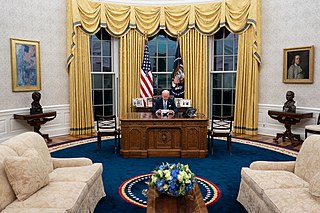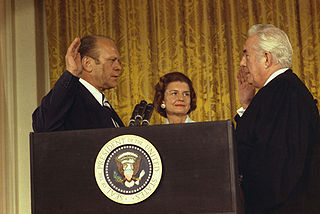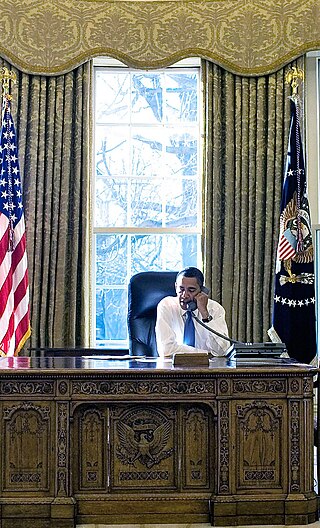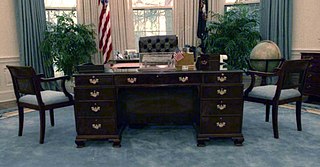
The swimming pool at the White House, the official residence of the president of the United States, is located on the South Lawn near the West Wing.

The swimming pool at the White House, the official residence of the president of the United States, is located on the South Lawn near the West Wing.
The 20-foot (6.1 m) wide and 50-foot (15 m) long pool was created in 1975 by Gerald Ford during his presidency. Before becoming president, Ford swam twice daily at his home in Alexandria, Virginia; early in the morning and after work in the evening. Ford regretted the White House no longer had a swimming pool and did not find playing golf as satisfying for exercise as swimming. The New York Times reported that the pool was built "over strong opposition from his [Ford's] advisers" as Ford had stressed budgetary restraint upon taking office in 1974. Aides had reportedly warned Ford that the construction of a pool would ensure that he only lasted a year in the presidency and should wait until after his potentially successful re-election in 1976. [1]
The area had previously been part of the South Lawn, with a natural screen of bushes and trees. Ford was a regular swimmer and demonstrated his swimming for the press when the pool was completed. [2] The photographer Dick Swanson of People took a picture from the bottom of the pool of Ford swimming. [3] In 1933, an indoor swimming pool had been built for President Franklin D. Roosevelt for his physical therapy for polio. The pool was covered over in 1970 when the space was remodeled as the Press Briefing Room. [2]

A cabana was later added to the pool, with showers and changing facilities, and an underground passage connects the cabana to the West Wing for security. The cabana is solar powered with heated pipes providing hot water with the remaining heat going to the outdoor spa. It was renovated in 2002 with extra windows and a raised roof. [2]
Ford's son, Jack, learned to scuba dive in the pool, and 39th President Jimmy Carter's daughter Amy frequently dived in the pool. [2] Barbara Bush often swam in the pool; in 1990, a rat swam past her and was subsequently drowned by her husband, 41st President George H. W. Bush. Barbara Bush said that she "[swam] with a mask, and it just went right by in front of me...Fortunately, George Bush was there and drowned the beast. It was horrible". [4] Hillary Clinton was also a frequent user of the pool. Clinton had considered recreating the indoor pool of the White House and creating a new space for the media. As part of the White House grounds, the pool and its cabana are the responsibility of the National Park Service. [2]
In the first year of his presidency, Barack Obama wrote that he would leave the Oval Office and "have a cigarette (or two)" by the cabana, "savoring a quieter moment and letting my thoughts wander and deepen". [5]
The cost of the pool was estimated at $52,417 (equivalent to $285,068in 2022). It was entirely funded by private contributions, with donations limited to $1,000 (equivalent to $5,438in 2022). A swimming pool committee oversaw the construction of the pool; it was chaired by the vice chairman of the United States Olympic swimming committee, A. J. Sehorn. [1]
Imperial presidency is a term applied to the modern presidency of the United States. It became popular in the 1960s and served as the title of a 1973 book by historian Arthur M. Schlesinger, Jr., who wrote The Imperial Presidency to address two concerns: that the presidency was uncontrollable and that it had exceeded its constitutional limits. According to professor of political science Thomas E. Cronin, author of The State of the Presidency, the imperial presidency is a term used to define a danger to the American constitutional system by allowing presidents to create and abuse presidential prerogatives during national emergencies. This was based on: (1) presidential war powers vaguely defined in the Constitution, and (2) secrecy – a system used that shielded the Presidency from the usual checks and balances afforded by the legislative and judicial branches.

The Oval Office is the formal working space of the president of the United States. Part of the Executive Office of the President of the United States, it is in the West Wing of the White House, in Washington, D.C.

In political studies, surveys have been conducted in order to construct historical rankings of the success of the presidents of the United States. Ranking systems are usually based on surveys of academic historians and political scientists or popular opinion. The scholarly rankings focus on presidential achievements, leadership qualities, failures and faults. Popular-opinion polls typically focus on recent or well-known presidents.

A speechwriter is a person who is hired to prepare and write speeches that will be delivered by another person. Speechwriters are employed by many senior-level elected officials and executives in the government and private sectors. They can also be employed to write for weddings and other social occasions.

The Map Room is a room on the ground floor of the White House, the official home of the president of the United States.

The Cross Hall is a broad hallway on the first floor in the White House, the official residence of the president of the United States. It runs east to west connecting the State Dining Room with the East Room. The room is used for receiving lines following a State Arrival Ceremony on the South Lawn, or a procession of the President and a visiting head of state and their spouses.

Peter Eleftherios Baker is an American journalist and author. He is the chief White House correspondent for The New York Times and a political analyst for MSNBC, and was previously a reporter for The Washington Post for 20 years. Baker has covered five presidencies, from Bill Clinton through Joe Biden.

The South Lawn at the White House in Washington, D.C., is directly south of the house and is bordered on the east by East Executive Drive and the Treasury Building, on the west by West Executive Drive and the Old Executive Office Building, and along its curved southern perimeter by South Executive Drive and a large circular public lawn called The Ellipse.
The vice president-elect of the United States is the candidate who has won election to the office of vice president of the United States in a United States presidential election, but is awaiting inauguration to assume the office.

The Truman Balcony is the second-floor balcony of the Executive Residence of the White House, which overlooks the South Lawn. It was completed in March 1948, during the presidency of Harry S. Truman.

The inauguration of Gerald Ford as the 38th president of the United States was held on Friday, August 9, 1974, in the East Room of the White House in Washington, D.C., after President Richard Nixon resigned due to the Watergate scandal. The inauguration – the last non-scheduled, extraordinary inauguration to take place in the 20th century – marked the commencement of Gerald Ford's only term as president. Chief Justice Warren E. Burger administered the oath of office. The Bible upon which Ford recited the oath was held by his wife, Betty Ford, open to Proverbs 3:5–6. Ford was the ninth vice president to succeed to the presidency intra-term, and he remains the most recent to do so, as of 2024.

The first 100 days of Barack Obama's presidency began on January 20, 2009, the day Barack Obama was inaugurated as the 44th president of the United States. The first 100 days of a presidential term took on symbolic significance during Franklin D. Roosevelt's first term in office, and the period is considered a benchmark to measure the early success of a president. The 100th day of his presidency ended at noon on April 30, 2009. Obama stated that he should not be judged just by his first hundred days: "The first hundred days is going to be important, but it’s probably going to be the first thousand days that makes the difference." Obama began to formally create his presidential footprint during his first 100 days. Obama quickly began attempting to foster support for his economic stimulus package, American Recovery and Reinvestment Act of 2009. The bill passed in the House on January 28, 2009, by a 244–188 vote, and it passed in the Senate on February 10 by a 61–37 margin.

The White House has had multiple vegetable gardens since its completion in 1800. Eleanor Roosevelt, Hillary Clinton and Michelle Obama all have had their own versions of vegetable gardens. Roosevelt planted the White House victory garden during World War II to promote the use of victory gardens by American citizens in a time of possible food scarcity. Hillary Clinton had a vegetable garden constructed on the roof of the White House. On March 20, 2009, Michelle Obama broke ground on the largest and most expansive vegetable garden to date on the White House lawn.

The Reagan era or Age of Reagan is a periodization of recent American history used by historians and political observers to emphasize that the conservative "Reagan Revolution" led by President Ronald Reagan in domestic and foreign policy had a lasting impact. It overlaps with what political scientists call the Sixth Party System. Definitions of the Reagan era universally include the 1980s, while more extensive definitions may also include the late 1970s, the 1990s, and even the 2000s. In his 2008 book, The Age of Reagan: A History, 1974–2008, historian and journalist Sean Wilentz argues that Reagan dominated this stretch of American history in the same way that Franklin D. Roosevelt and his New Deal legacy dominated the four decades that preceded it.

The C&O desk is one of six desks ever used in the Oval Office by a sitting President of the United States. The C&O Desk was used in the executive office by only George H. W. Bush, making it one of two Oval Office desks to be used by only one president there. Prior to its use in the Oval Office by Bush, the desk had been in use elsewhere in the White House. It is the shortest-serving Oval Office desk to date, having been used for one four-year term.

Barack Obama served as the 44th President of the United States from 2009 to 2017. Before his presidency, he served in the Illinois Senate (1997–2004) and the United States Senate (2005–2008).

Ten United States presidents have made presidential visits to the Middle East. The first trips by an incumbent president to countries in the Middle East were those by Franklin D. Roosevelt, and were an offshoot of Allied diplomatic interactions during World War II. To date, 16 visits have been made to Egypt, 12 to Saudi Arabia, 11 to Israel, six to both Iraq, Jordan and Turkey, four to Iran, three to the Palestinian Territories, two to both Kuwait and Syria, one to Bahrain, Georgia, Oman, Qatar, and to the United Arab Emirates. No incumbent American president has yet visited Armenia, Azerbaijan, Cyprus, Lebanon, and Yemen.
The tennis court at the White House, the official residence of the president of the United States in Washington, D.C., is located on the South Lawn. Lines have been drawn, and baskets have since been added to the court for use as a basketball court.